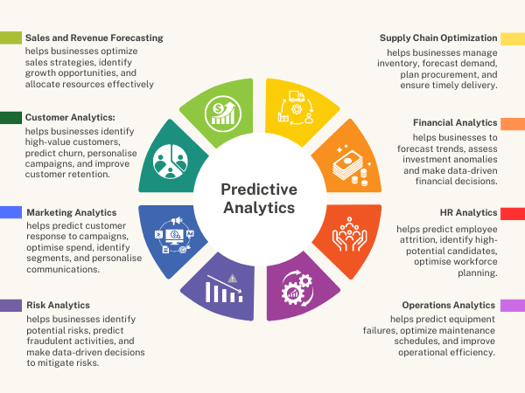What is Predictive Analytics?
Predictive analytics uses statistical algorithms and machine learning techniques to process historical data to anticipate future events or outcomes. A simple use case is extracting patterns and relationships from large datasets to identify trends, patterns, and probabilities. Businesses apply such predictive analysis to make data-driven decisions and take proactive measures to improve outcomes.
Applications of Predictive Analytics
Business areas like sales, finance, marketing, and supply chain adopt predictive analytics to forecast customer behavior. Other business processes that potentially benefit from predictive analytics are process optimization, fraud detection, and inventory management, with the diagram below providing more information on how predictive analytics supports.

This article will focus on predictive analytics and its utilization in the sales landscape.
Role of Predictive Analytics in Sales
When applied in Sales, predictive analytics focuses on capturing retrospective sales data, analyzing it, and making predictions about future sales performance. It involves using statistical models and machine learning algorithms. The elements under analysis are sales data, customer information, and market trends. It also considers other relevant variables to identify patterns, correlations, and factors influencing sales outcomes.
How is sales prediction analytics helping businesses?
Sales predictive analytics helps businesses gain insights into customer behavior, sales patterns, and market dynamics. It also enables them to make informed decisions and develop effective sales strategies. Analytics can help businesses in many ways such as forecasting sales volumes, identifying high-potential leads, improving sales forecasting accuracy, and enhancing overall sales performance.
Sales predictive analytics help businesses classify customers based on their likelihood to make a purchase and identify critical factors that contribute to sales success. High-performing sales teams often use predictive analytics to meet their sales objectives. The insights derived from sales predictive analytics can be a go-to guide for sales teams, helping to target the right customers, optimize resource allocation, and maximize revenue generation.
Examples of sales predictive analytics
Customer Churn Prediction
Predictive analytics can identify customers who are at risk of churning or discontinuing their relationship with a business. By analyzing customer data, behavior patterns, and engagement metrics, predictive models can identify early warning signs of potential churn, allowing companies to take proactive measures. Such measures include targeted retention campaigns and personalized offers. Which can help retain at-risk customers and maximize customer lifetime value.
Lead Scoring and Conversion Prediction
Lead scoring uses predictive analytics to predict the likelihood of a prospect converting into a customer. The company will analyze historical customer data, demographics, purchase history, and online behavior. It helps develop predictive models that assign a score or probability to each lead. Hence, sales teams can prioritize leads and focus on high-potential prospects, increasing conversion rates and optimizing sales efforts.
Sales Forecasting
Sales predictive analytics can help businesses forecast future sales volumes and trends based on historical data, market conditions, and other relevant factors. It helps in identifying patterns and correlations in past sales data. Businesses can make accurate predictions for future sales performance using that data. Hence, it enables them to allocate resources better, plan inventory levels, and make informed business decisions.
6 benefits of predictive analytics for any business
With companies producing more and more data points, the business case for predictive analytics is growing and becoming more widespread. Initially reserved only for technically minded people and companies, it is becoming a more commonly adopted tool.
Let’s find out why businesses use predictive analytics.
1. Improve production efficiency
The benefits of predictive analytics for the production or manufacturing sector are particularly prevalent. Using predictive analytics, companies can effectively forecast inventory and required production rates. Additionally, your team can estimate and prevent potential production failures using past data.
Predictive analytics can optimize predictive maintenance schedules and reduce equipment downtime. Businesses can also utilize forecasting to address supply chain disruptions and avoid costly setbacks.
2. Gain an advantage over competitors
Predictive analytics gives businesses insight into their existing database; tapping into the available customer data helps you understand why you are losing customers to your competitors. It can also help identify unique selling points to acquire qualified leads.
Predictive analytics helps in delivering enhanced customer experience. Businesses can analyze customer data, preferences, and behavior to personalize their value proposition. This personalized approach can help companies to differentiate themselves from competitors and build stronger customer relationships.
3. Reduce risk
Risk identification and reduction teams regularly use predictive analytics. The banking, financial services, and insurance sectors use predictive analytics to help screen individuals and businesses. It helps form a more reliable interpretation of that person, business, or incident and can be used to make effective decisions.
Furthermore, businesses can use predictive analytics to develop risk mitigation strategies. It can create scenario simulations for businesses to identify the most effective approach.
4. Detect fraud
One of the most beneficial uses of predictive analysis is fraud detection. The process is particularly attuned to fraud detection and prevention. It happens by recognizing behavioral patterns. It can track changes in this behavior on a site or network. Hence, spot anomalies that may indicate threat or fraud, which can then be highlighted and prevented.
Predictive analytics can operate in real-time, allowing businesses to detect and respond to fraud as it happens. Predictive analytics assigns risk scores or probabilities to transactions or activities based on historical patterns. These scores indicate the likelihood of fraudulent behavior.
5. Better sales and marketing efforts
You've started your sales campaign; it's out in full swing and performing well. But could it be performing better? Do you need to take advantage of further opportunities?
Predictive analytics' core purpose is sifting through data and providing informed predictions on what to expect. It can look at consumer data for specific campaigns and tell you what's working and what isn't. It can prepare an action plan to identify cross-sell and upsell opportunities.
Predictive analytics can analyze customer data to identify distinct segments based on behavior, demographics, preferences, or purchasing patterns. By understanding these segments, salespeople can plan targeted activities tailored to each segment's specific needs and preferences.
It can also estimate the potential value of each customer over their entire relationship with the business. It helps analyze past purchase data, average order value, frequency of purchases, and customer behavior. Subsequently, companies can prioritize marketing efforts on customers with higher Customer Lifetime Value (CLV).
6. Meet consumer expectations
Predictive analytics gathers customer data from various sources, such as purchase history, browsing behavior, feedback, and social media interactions. Businesses can tailor their products, services, and experiences to meet customer expectations. It is all made possible by understanding customer preferences, interests, and motivations.
Additionally, predictive analytics can forecast customer demand based on historical data, market trends, and external factors. Businesses can ensure the availability of products or services. They can also prevent stockouts or overstocking and meet customer expectations for timely delivery or service availability.
Predictive analytics enables businesses to refine and continually improve their understanding of customer expectations. It equips businesses with customer behavioral and campaign performance insights. Hence, companies can adapt their strategies and offerings to align better with evolving customer expectations.
Undoubtedly, without predictive technology, your world would be a very different place. Although the name suggests a degree of risk – it results in the opposite. Hence, data-driven predictions are valuable across disciplines and industries of all kinds.
Have you thought about what predictive analytics can do for you?
sales-i is helping businesses sell smarter by optimizing their sales processes. With sales-i, you can identify potential threats and new sales opportunities. To know more about how sales-i can help you amplify your sales, book your 30-minute free demo and see sales-i in action.



%EF%B9%96width=1080&height=228&name=Want%20to%20find%20out%20more%20about%20how%20sales-i%20can%20mix%20your%20hard%20and%20soft%20data%20together%20(2).png)